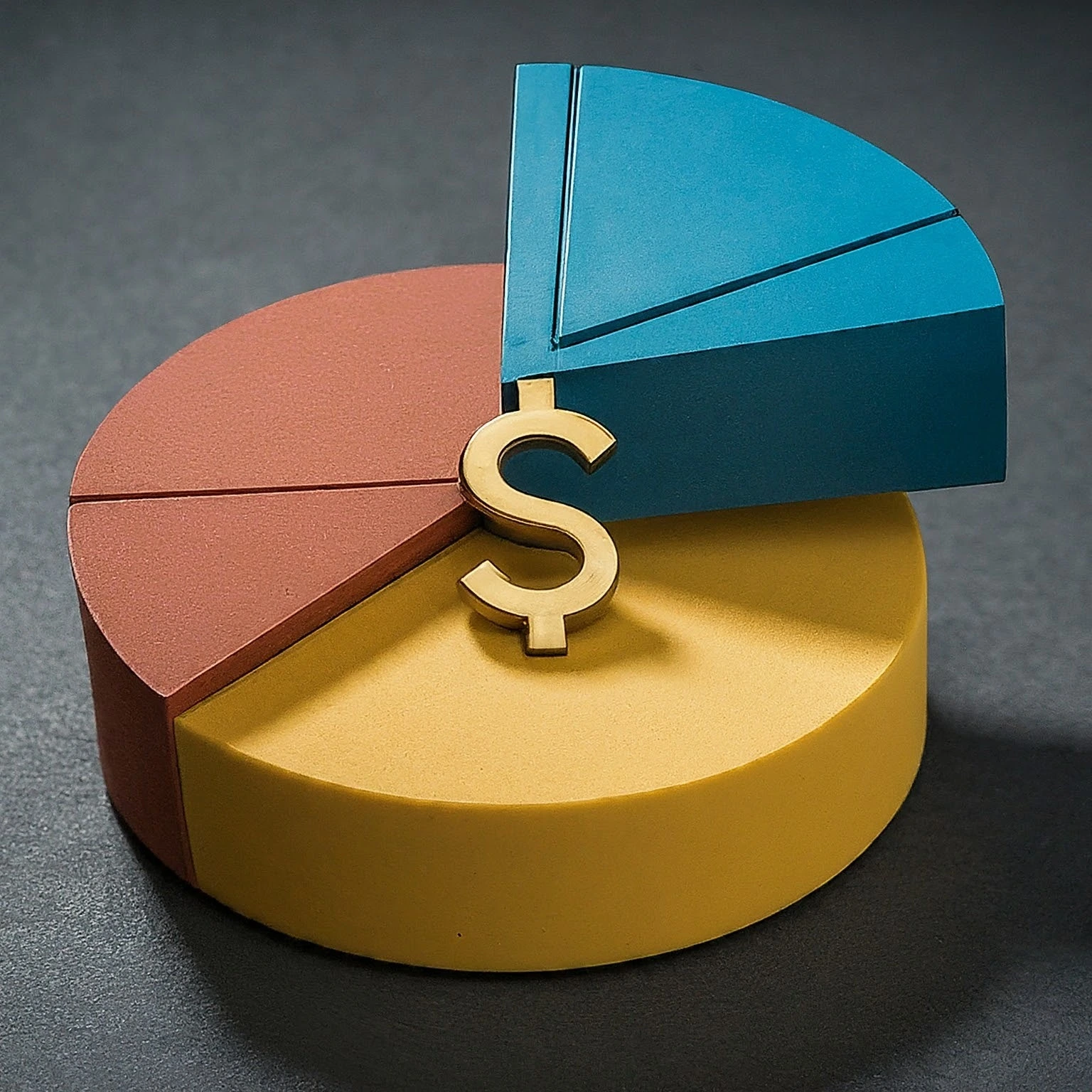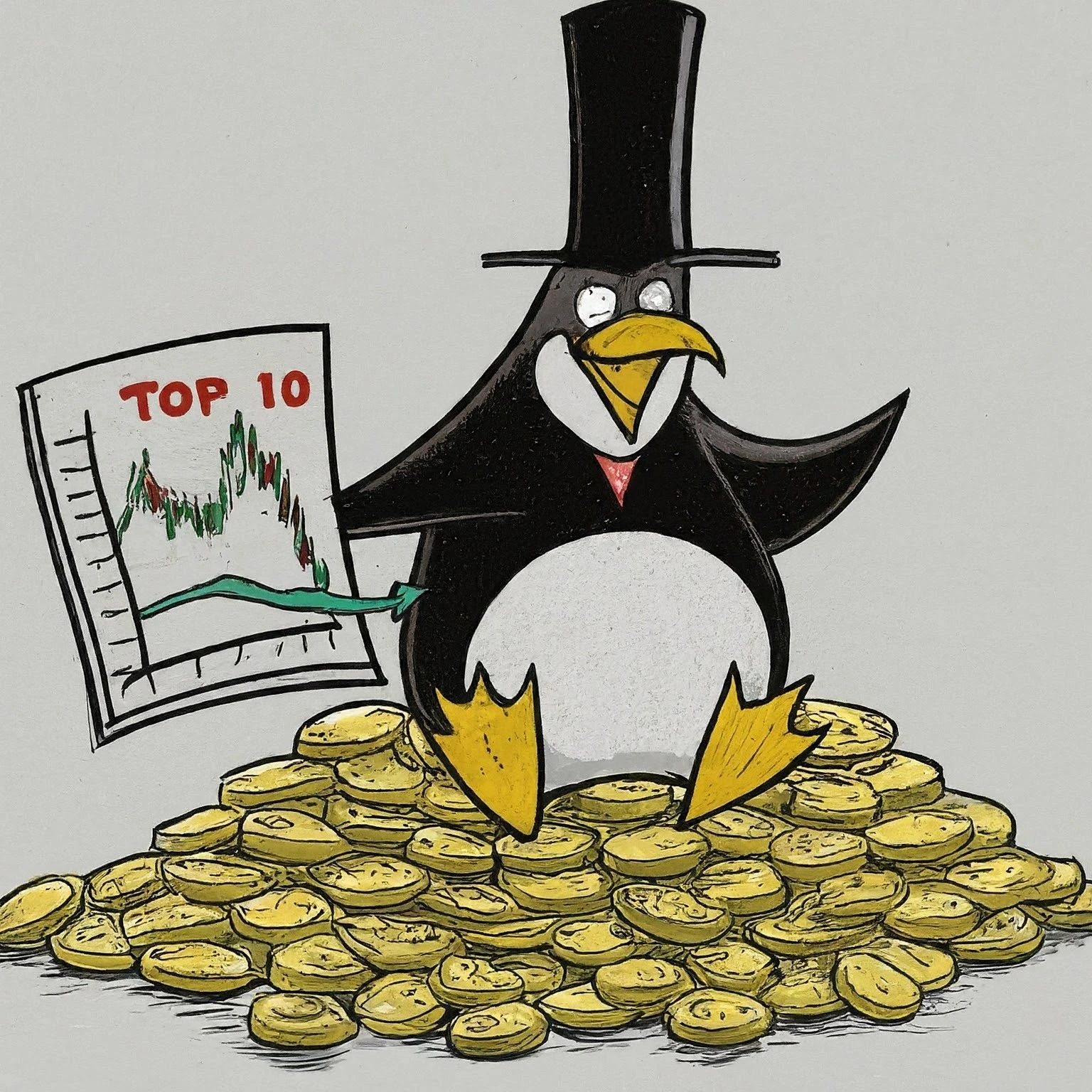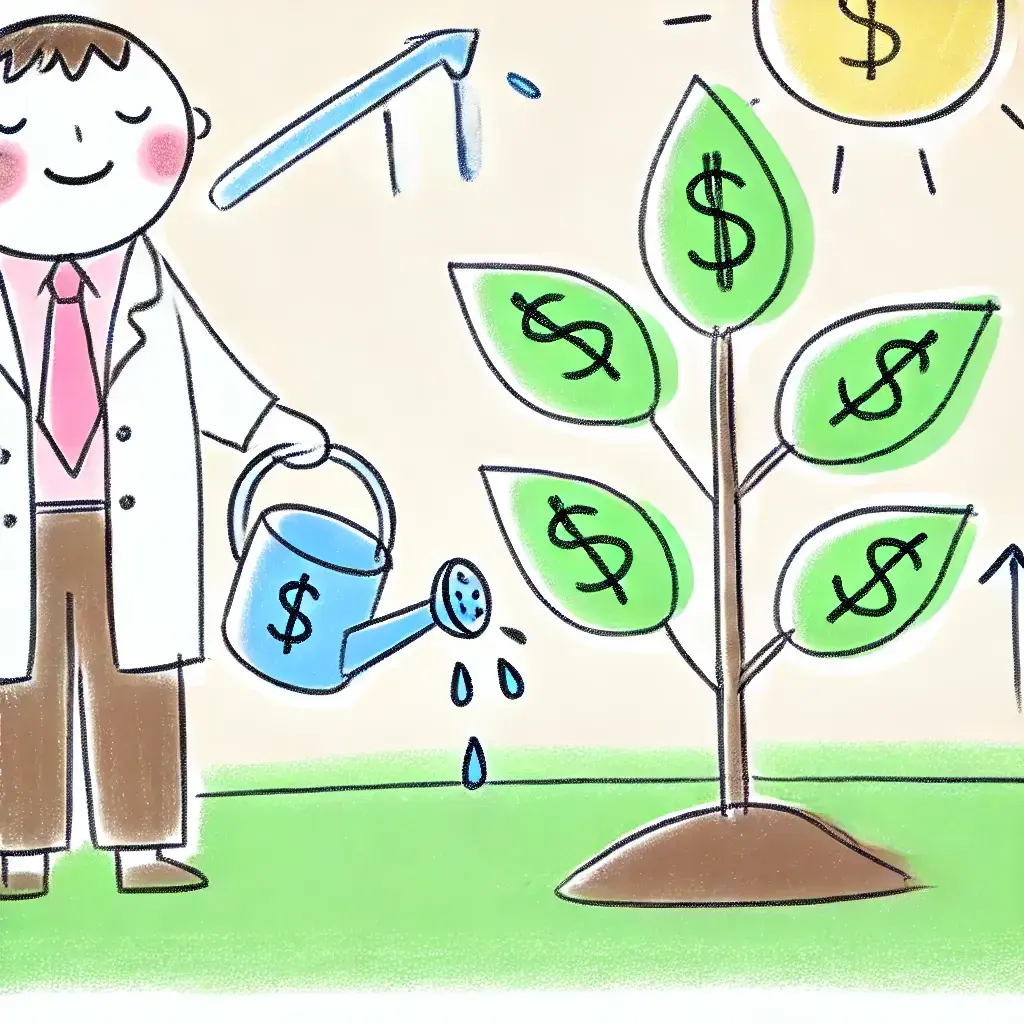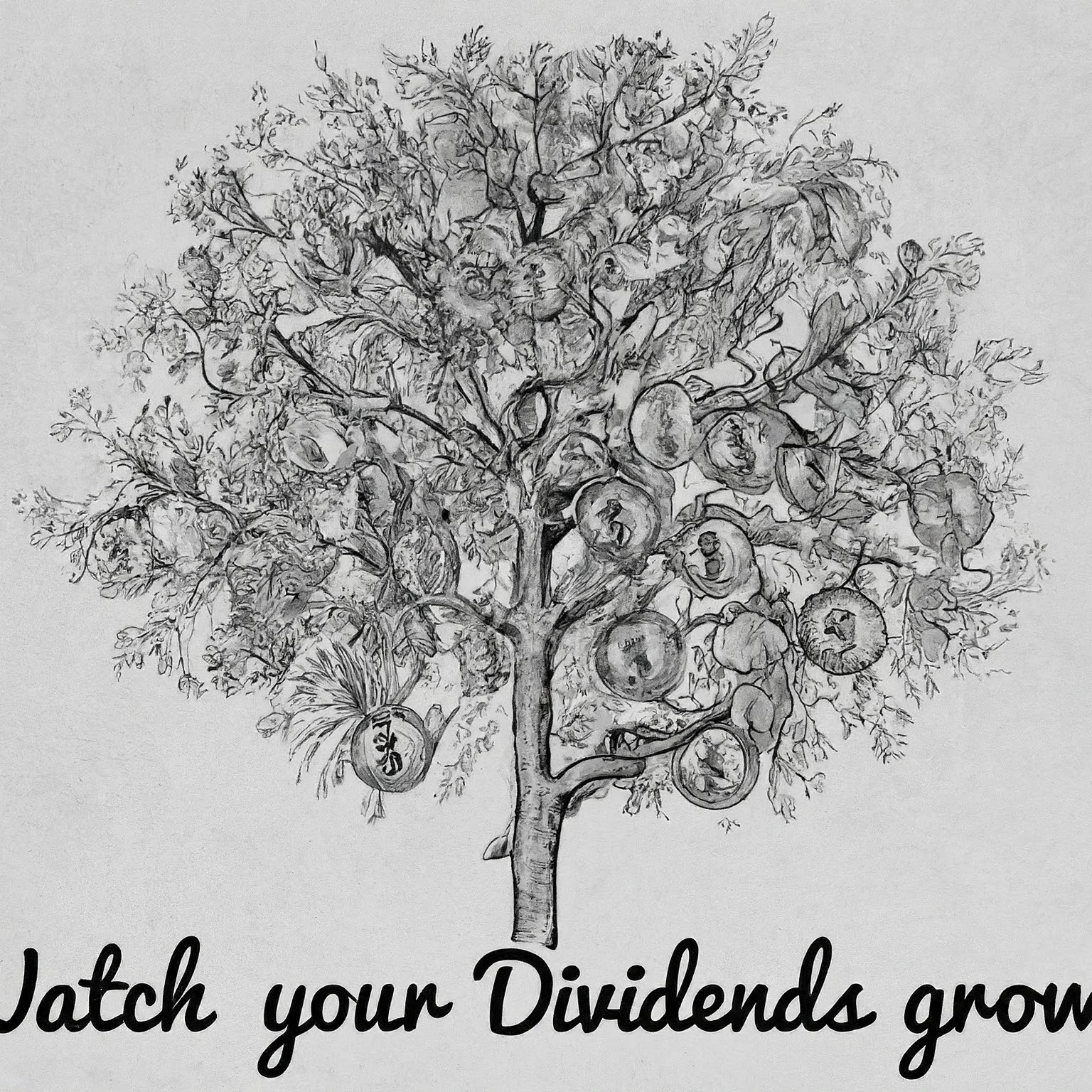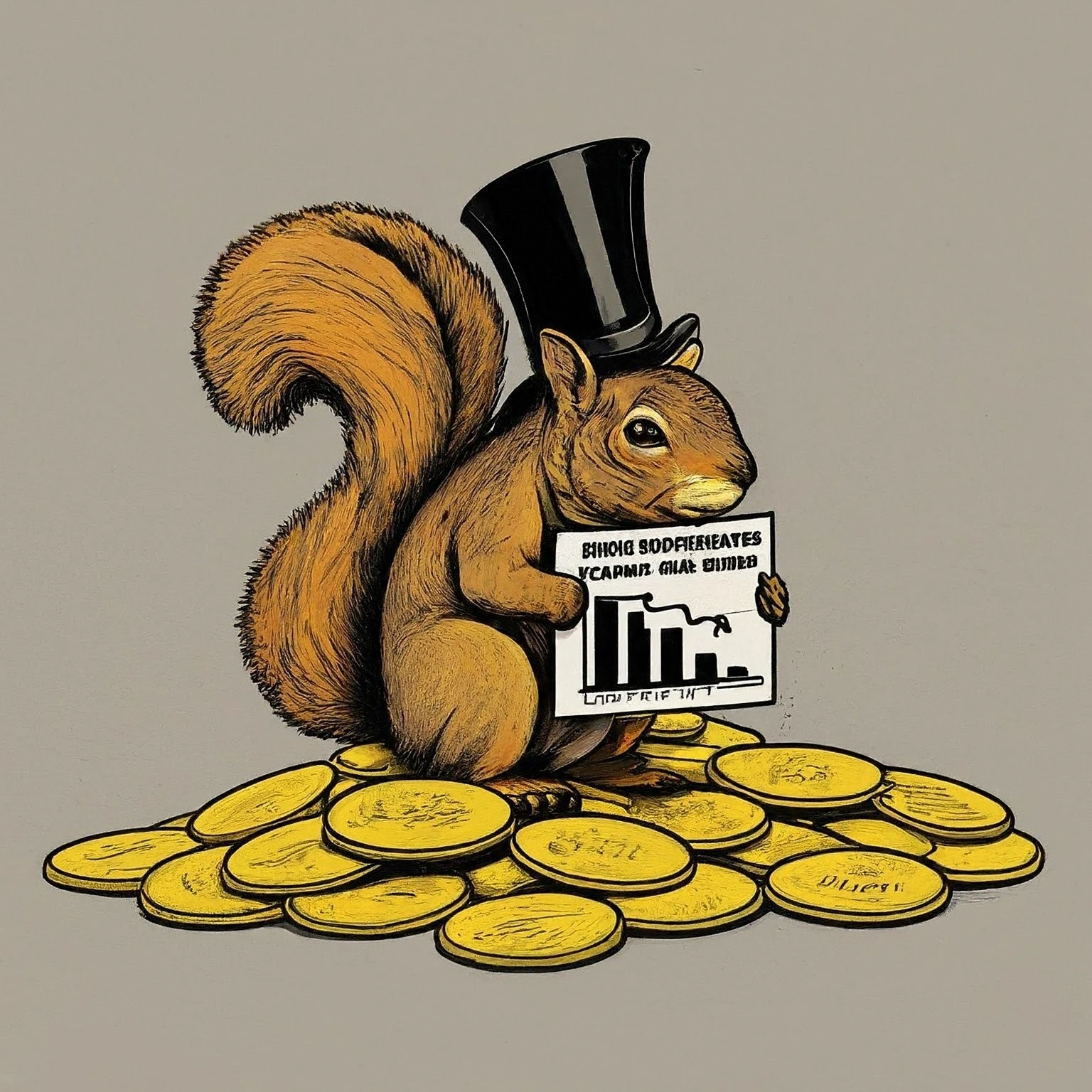
Dividend Investing
Dividend investing is an investment strategy focused on purchasing stocks or other securities that regularly distribute a portion of their earnings to shareholders in the form of dividends. The primary goal is to generate a steady income stream, either for reinvestment or as a source of regular cash flow. Investors often target companies with a history of stable or increasing dividend payments, as these are typically viewed as financially strong and reliable. Dividend investing can provide both income and potential for capital appreciation, making it a popular strategy for long-term investors, particularly those seeking passive income or stability in their investment portfolio.
Dividend Investing Guide




Dividend Investing Glossary
- Annual Dividend(Noun)
- /an-yoo-uhl div-i-dend/
- Definition: The total amount of dividend income received by a shareholder over the course of a year, typically expressed as a monetary amount per share.
- Etymology: "Annual" from Latin "annus," meaning "year," and "dividend" from Latin "dividendum," meaning "a thing to be divided." Annual dividend reflects the yearly payout to shareholders.
- Similar: Yearly dividend, Annual payout
- Opposite: Quarterly dividend
- Example: "The company declared an annual dividend of $3 per share, payable to shareholders at the end of the fiscal year."
- Blue Chip Stocks(Noun)
- /bloo chip stoks/
- Definition: Shares of large, reputable, and financially stable companies with a history of reliable performance, often considered safe investments with consistent dividend payments.
- Etymology: "Blue chip" from poker, where blue chips are the highest value, and "stocks" from Old English "stocc," meaning "a tree trunk." Blue chip stocks represent high-quality investments.
- Similar: Large-cap stocks, Safe stocks
- Opposite: Penny stocks
- Example: "Investors seeking stability often include blue chip stocks in their portfolios due to their consistent dividend payments."
- Bond-Like Stocks(Noun)
- /bond-lahyk stoks/
- Definition: Stocks that provide stable and predictable dividend payments, similar to the fixed interest payments of bonds, often found in companies with low volatility and steady cash flows.
- Etymology: "Bond" from Latin "bond," meaning "to bind," and "stocks" from Old English "stocc," meaning "a tree trunk." Bond-like stocks offer income stability similar to bonds.
- Similar: Defensive stocks, Stable dividend stocks
- Opposite: Growth stocks
- Example: "Bond-like stocks are appealing to conservative investors who prioritize income stability over capital gains."
- Cash Dividend(Noun)
- /kash div-i-dend/
- Definition: A payment made by a corporation to its shareholders in the form of cash, typically distributed on a quarterly or annual basis, representing a share of the company’s profits.
- Etymology: "Cash" from Old French "casse," meaning "money box," and "dividend" from Latin "dividendum," meaning "a thing to be divided." Cash dividends are direct payments to shareholders.
- Similar: Dividend payout, Cash distribution
- Opposite: Stock dividend
- Example: "The company declared a cash dividend of $0.50 per share, payable to shareholders on the record date."
- Consistent Dividend(Noun)
- /kon-sis-tuhnt div-i-dend/
- Definition: A dividend that is regularly paid out to shareholders without interruption over a long period, reflecting the stability and reliability of the issuing company.
- Etymology: "Consistent" from Latin "consistere," meaning "to stand firm," and "dividend" from Latin "dividendum," meaning "a thing to be divided." Consistent dividends indicate financial health.
- Similar: Reliable dividend, Regular payout
- Opposite: Irregular dividend
- Example: "Investors favor companies with a consistent dividend, as it suggests reliable income and corporate stability."
- Consumer Staples(Noun)
- /kuhn-soo-mer stay-puhls/
- Definition: A sector of the stock market that includes companies producing essential goods, such as food, beverages, and household items, which tend to have stable earnings and consistent dividends.
- Etymology: "Consumer" from Latin "consumere," meaning "to use up," and "staples" from Old English "stapol," meaning "pillar." Consumer staples are essential products with inelastic demand.
- Similar: Essential goods, Defensive sector
- Opposite: Consumer discretionary
- Example: "Consumer staples are often included in dividend portfolios for their stability and reliable payouts during economic downturns."
- Defensive Dividend Stocks(Noun)
- /dih-fen-siv div-i-dend stoks/
- Definition: Stocks of companies that are considered less volatile and provide consistent dividends, often found in industries like utilities, healthcare, and consumer staples, which are less sensitive to economic cycles.
- Etymology: "Defensive" from Latin "defensivus," meaning "serving to defend," and "dividend" from Latin "dividendum," meaning "a thing to be divided." Defensive dividend stocks offer stability during market volatility.
- Similar: Safe dividend stocks, Conservative stocks
- Opposite: Cyclical stocks
- Example: "Defensive dividend stocks are often chosen for portfolios designed to weather economic downturns."
- Dividend Accumulation(Noun)
- /div-i-dend uh-kyoom-yuh-lay-shuhn/
- Definition: The process of reinvesting dividends back into the underlying stock or into additional shares, allowing the investor to accumulate more shares over time, thereby increasing future dividend income.
- Etymology: "Dividend" from Latin "dividendum," meaning "a thing to be divided," and "accumulation" from Latin "accumulare," meaning "to heap up." Dividend accumulation grows investment holdings over time.
- Similar: Reinvestment, Dividend compounding
- Opposite: Dividend withdrawal
- Example: "Dividend accumulation is a powerful strategy for long-term investors seeking to compound their returns."
- Dividend Achievers(Noun)
- /div-i-dend uh-cheev-ers/
- Definition: A designation for companies that have consistently increased their dividends for at least 10 consecutive years, often considered reliable and stable investments for income-focused portfolios.
- Etymology: "Dividend" from Latin "dividendum," meaning "a thing to be divided," and "achievers" from Old French "achever," meaning "to complete." Dividend achievers are companies with a proven track record of increasing dividends.
- Similar: Dividend growers, Consistent dividend payers
- Opposite: Inconsistent dividend payers
- Example: "Dividend achievers are highly sought after by investors looking for reliable income growth over time."
- Dividend Adjusted Return(Noun)
- /div-i-dend uh-juhs-ted ri-turn/
- Definition: A measure of the total return on an investment that includes both capital gains and the reinvested dividends, providing a more accurate reflection of an investment’s performance.
- Etymology: "Dividend" from Latin "dividendum," meaning "a thing to be divided," "adjusted" from Old French "ajuster," meaning "to bring into agreement," and "return" from Old French "retourner," meaning "to turn back." Dividend adjusted return captures the full impact of dividends on investment returns.
- Similar: Total return, Reinvested return
- Opposite: Price return
- Example: "The dividend adjusted return of the stock was higher than its price return, reflecting the importance of reinvested dividends."
- Dividend Aristocrat ETF(Noun)
- /div-i-dend uh-ris-tuh-krat ee-tee-ef/
- Definition: An exchange-traded fund (ETF) that invests in companies classified as Dividend Aristocrats, which are S&P 500 companies that have increased their dividends for at least 25 consecutive years.
- Etymology: "Dividend" from Latin "dividendum," meaning "a thing to be divided," "Aristocrat" from Greek "aristokratia," meaning "rule of the best," and "ETF" from "exchange-traded fund." A Dividend Aristocrat ETF provides exposure to reliable dividend payers.
- Similar: Aristocrat fund, Dividend ETF
- Opposite: Growth ETF
- Example: "Investors looking for steady income often choose a Dividend Aristocrat ETF to gain exposure to top dividend-paying companies."
- Dividend Aristocrats(Noun)
- /div-i-dend uh-ris-tuh-krats/
- Definition: A select group of S&P 500 companies that have consistently increased their dividends for 25 consecutive years or more, often seen as reliable and stable investments.
- Etymology: "Dividend" from Latin "dividendum," meaning "a thing to be divided," and "Aristocrats" from Greek "aristokratia," meaning "rule of the best." Dividend Aristocrats are elite companies known for their consistent dividend growth.
- Similar: Dividend kings, Elite dividend payers
- Opposite: Non-dividend paying stocks
- Example: "Dividend Aristocrats are considered a safe bet for investors seeking both income and capital preservation."
- Dividend Calendar(Noun)
- /div-i-dend kal-en-der/
- Definition: A schedule that lists the dates of upcoming dividend payments for various stocks, including the ex-dividend date, record date, and payment date, used by investors to plan dividend income.
- Etymology: "Dividend" from Latin "dividendum," meaning "a thing to be divided," and "calendar" from Latin "calendarium," meaning "account book." A dividend calendar helps investors keep track of dividend payments.
- Similar: Dividend schedule, Payout calendar
- Example: "Using a dividend calendar, investors can track when they will receive income from their stock holdings."
- Dividend Capture Strategy(Noun)
- /div-i-dend kap-cher strat-uh-jee/
- Definition: An investment strategy where an investor purchases a stock just before its ex-dividend date and sells it shortly after the dividend is paid, aiming to capture the dividend income.
- Etymology: "Dividend" from Latin "dividendum," meaning "a thing to be divided," "capture" from Latin "captura," meaning "to take," and "strategy" from Greek "strategia," meaning "generalship." The dividend capture strategy focuses on short-term income generation through dividends.
- Similar: Dividend play, Ex-dividend strategy
- Opposite: Long-term dividend investing
- Example: "The dividend capture strategy can generate quick income, but it involves frequent trading and market timing risks."
- Dividend Cover(Noun)
- /div-i-dend kuh-ver/
- Definition: A financial ratio that measures a company’s ability to pay dividends to its shareholders, calculated by dividing net income by the total dividends paid, indicating the safety of the dividend payment.
- Etymology: "Dividend" from Latin "dividendum," meaning "a thing to be divided," and "cover" from Old English "cofra," meaning "to protect." Dividend cover assesses the sustainability of a company's dividend payments.
- Similar: Dividend coverage ratio, Payout coverage
- Opposite: Dividend shortfall
- Example: "A high dividend cover indicates that the company has sufficient earnings to maintain its dividend payments."
- Dividend Cumulative Growth(Noun)
- /div-i-dend kyoo-myuh-luh-tiv grohth/
- Definition: The total increase in dividend payments over a specific period, often measured as a percentage, reflecting the company's ability to grow its dividend consistently over time.
- Etymology: "Dividend" from Latin "dividendum," meaning "a thing to be divided," "cumulative" from Latin "cumulare," meaning "to heap," and "growth" from Old English "growan," meaning "to grow." Dividend cumulative growth measures the increase in dividends over time.
- Similar: Dividend growth rate, Dividend increase
- Opposite: Dividend decline
- Example: "Investors track dividend cumulative growth to assess the potential for future income increases."
- Dividend Cushion(Noun)
- /div-i-dend koo-shuhn/
- Definition: A metric that assesses the safety of a company's dividend by comparing its cash flow after capital expenditures to its dividend obligations, with a higher cushion indicating a more secure dividend.
- Etymology: "Dividend" from Latin "dividendum," meaning "a thing to be divided," and "cushion" from Old French "coissin," meaning "a soft pad." The dividend cushion reflects the company's ability to maintain its dividend payouts.
- Similar: Dividend safety margin, Payout buffer
- Opposite: Dividend risk
- Example: "A strong dividend cushion suggests that the company can comfortably cover its dividend payments even in tough times."
- Dividend Cut(Noun)
- /div-i-dend kuht/
- Definition: A reduction in the dividend payment made by a company, often due to financial difficulties or a need to conserve cash, which can negatively impact the stock price and investor confidence.
- Etymology: "Dividend" from Latin "dividendum," meaning "a thing to be divided," and "cut" from Old English "cyttan," meaning "to shorten." A dividend cut typically signals financial trouble within the company.
- Similar: Dividend reduction, Payout decrease
- Opposite: Dividend increase
- Example: "The announcement of a dividend cut led to a sharp decline in the company’s stock price."
- Dividend Discount Model(Noun)
- /div-i-dend dis-kount mod-l/
- Definition: A valuation method used to estimate the intrinsic value of a stock based on the present value of its expected future dividends, often used to assess whether a stock is overvalued or undervalued.
- Etymology: "Dividend" from Latin "dividendum," meaning "a thing to be divided," "discount" from Latin "discomputare," meaning "to count down," and "model" from Latin "modulus," meaning "a measure." The dividend discount model evaluates stock value based on future dividends.
- Similar: DDM, Dividend valuation model
- Opposite: Price/earnings ratio (in some contexts)
- Example: "Investors use the dividend discount model to determine if a stock's current price is justified by its future dividend payments."
- Dividend ETF(Noun)
- /div-i-dend ee-tee-ef/
- Definition: An exchange-traded fund that focuses on investing in dividend-paying stocks, providing investors with diversified exposure to companies known for regular dividend payments.
- Etymology: "Dividend" from Latin "dividendum," meaning "a thing to be divided," and "ETF" from "exchange-traded fund." A dividend ETF offers a way to invest in a basket of dividend-paying stocks.
- Similar: Income ETF, Dividend fund
- Opposite: Growth ETF
- Example: "Dividend ETFs are popular among income-focused investors looking for a diversified portfolio of dividend-paying companies."
- Dividend Exclusion(Noun)
- /div-i-dend ik-skloo-zhuhn/
- Definition: A tax provision that allows a portion of dividend income to be excluded from taxable income, often used to encourage investment in dividend-paying stocks.
- Etymology: "Dividend" from Latin "dividendum," meaning "a thing to be divided," and "exclusion" from Latin "excludere," meaning "to shut out." Dividend exclusion provides a tax benefit for dividend income.
- Similar: Dividend tax exclusion, Tax-free dividend
- Opposite: Dividend tax inclusion
- Example: "Dividend exclusion allows investors to reduce their taxable income, making dividend-paying stocks more attractive."
- Dividend Forecast(Noun)
- /div-i-dend fawr-kast/
- Definition: An estimate of future dividend payments, often provided by analysts or the company itself, based on projected earnings and cash flow, helping investors predict income and assess the sustainability of dividends.
- Etymology: "Dividend" from Latin "dividendum," meaning "a thing to be divided," and "forecast" from Old English "fore," meaning "before," and "cast," meaning "to throw." A dividend forecast predicts future dividend payments.
- Similar: Dividend projection, Payout estimate
- Opposite: Dividend history
- Example: "The dividend forecast suggested a potential increase in payouts due to the company's strong earnings growth."
- Dividend Fund(Noun)
- /div-i-dend fuhnd/
- Definition: A mutual fund or exchange-traded fund (ETF) that invests primarily in dividend-paying stocks, aiming to provide investors with regular income through dividends.
- Etymology: "Dividend" from Latin "dividendum," meaning "a thing to be divided," and "fund" from Old French "fons," meaning "bottom or base." A dividend fund focuses on generating income from dividends.
- Similar: Income fund, Dividend-paying fund
- Opposite: Growth fund
- Example: "Dividend funds are suitable for investors seeking steady income from a diversified portfolio of dividend-paying stocks."
- Dividend Harvesting(Noun)
- /div-i-dend hahr-vest-ing/
- Definition: An investment strategy where an investor buys stocks or funds just before the ex-dividend date to capture the dividend and then sells them shortly after, aiming to generate regular income from dividends.
- Etymology: "Dividend" from Latin "dividendum," meaning "a thing to be divided," and "harvesting" from Old English "harvestian," meaning "to gather." Dividend harvesting focuses on capturing dividend payments through timely stock purchases.
- Similar: Dividend capture, Ex-dividend strategy
- Opposite: Long-term dividend investing
- Example: "Dividend harvesting can be profitable, but it requires careful timing and frequent trading."
- Dividend History(Noun)
- /div-i-dend his-tuh-ree/
- Definition: The record of a company's past dividend payments, including the amounts and frequency of payouts, used by investors to evaluate the reliability and consistency of the company’s dividend policy.
- Etymology: "Dividend" from Latin "dividendum," meaning "a thing to be divided," and "history" from Greek "historia," meaning "inquiry." Dividend history provides insights into a company's past performance in paying dividends.
- Similar: Payout history, Dividend record
- Opposite: Dividend forecast
- Example: "A strong dividend history is often a sign of a company's financial stability and commitment to returning value to shareholders."
- Dividend History Analysis(Noun)
- /div-i-dend his-tuh-ree uh-nal-uh-sis/
- Definition: The process of examining a company's historical dividend payments to assess its ability to maintain or grow its dividends in the future, often used by income-focused investors.
- Etymology: "Dividend" from Latin "dividendum," meaning "a thing to be divided," "history" from Greek "historia," meaning "inquiry," and "analysis" from Greek "analusis," meaning "a breaking up." Dividend history analysis evaluates the sustainability of a company's dividend policy.
- Similar: Dividend trend analysis, Payout analysis
- Example: "Dividend history analysis showed that the company had consistently increased its payouts for the past 20 years."
- Dividend Income(Noun)
- /div-i-dend in-kuhm/
- Definition: The earnings received by a shareholder from dividend payments made by the companies in which they own shares, often forming a significant part of the income for income-focused investors.
- Etymology: "Dividend" from Latin "dividendum," meaning "a thing to be divided," and "income" from Old English "incuman," meaning "to come in." Dividend income provides regular earnings to shareholders.
- Similar: Dividend earnings, Payout income
- Opposite: Capital gains (in some contexts)
- Example: "Dividend income from his stock portfolio supplemented his retirement savings, providing a steady cash flow."
- Dividend Income Fund(Noun)
- /div-i-dend in-kuhm fuhnd/
- Definition: A mutual fund or ETF that focuses on generating income through investments in dividend-paying stocks, often selected for their high yield and stability, catering to income-focused investors.
- Etymology: "Dividend" from Latin "dividendum," meaning "a thing to be divided," "income" from Old English "incuman," meaning "to come in," and "fund" from Old French "fons," meaning "bottom or base." A dividend income fund seeks to maximize income through dividend payments.
- Similar: Income-focused fund, High-yield fund
- Opposite: Growth fund
- Example: "A dividend income fund is an attractive option for investors looking to generate regular income from their investments."
- Dividend Increase(Noun)
- /div-i-dend in-krees/
- Definition: An upward adjustment in the amount of dividend payment made by a company to its shareholders, often indicating strong financial health and confidence in future earnings.
- Etymology: "Dividend" from Latin "dividendum," meaning "a thing to be divided," and "increase" from Latin "increscere," meaning "to grow." A dividend increase reflects a company’s commitment to returning value to shareholders.
- Similar: Payout increase, Dividend hike
- Opposite: Dividend cut
- Example: "The board approved a dividend increase, boosting the quarterly payout by 10%."
- Dividend Investing Plan(Noun)
- /div-i-dend in-ves-ting plan/
- Definition: A strategy or plan focused on building a portfolio of dividend-paying stocks to generate regular income, often involving the reinvestment of dividends to compound returns over time.
- Etymology: "Dividend" from Latin "dividendum," meaning "a thing to be divided," "investing" from Latin "investire," meaning "to clothe," and "plan" from Latin "planus," meaning "flat or level." A dividend investing plan systematically focuses on income generation and growth through dividends.
- Similar: Dividend strategy, Income investing plan
- Opposite: Growth investing plan
- Example: "His dividend investing plan involved selecting high-quality stocks with a strong history of dividend payments and reinvesting the income to buy more shares."
- Dividend Investor(Noun)
- /div-i-dend in-ves-ter/
- Definition: An individual who focuses on investing in stocks that pay dividends, often seeking to generate a regular income stream and potentially benefit from capital appreciation over the long term.
- Etymology: "Dividend" from Latin "dividendum," meaning "a thing to be divided," and "investor" from Latin "investire," meaning "to clothe." A dividend investor prioritizes income generation through dividends.
- Similar: Income investor, Dividend-focused investor
- Opposite: Growth investor
- Example: "As a dividend investor, she prioritizes stocks with a strong history of consistent payouts."
- Dividend Kings(Noun)
- /div-i-dend kings/
- Definition: Companies that have increased their dividend payouts for 50 consecutive years or more, representing the highest standard of reliability and commitment to returning value to shareholders.
- Etymology: "Dividend" from Latin "dividendum," meaning "a thing to be divided," and "kings" from Old English "cyning," meaning "ruler." Dividend kings are elite companies known for their exceptional dividend track records.
- Similar: Elite dividend payers, Top dividend companies
- Opposite: Dividend cutters
- Example: "Dividend Kings are often considered the gold standard for income investors seeking long-term reliability."
- Dividend Longevity(Noun)
- /div-i-dend lon-jev-i-tee/
- Definition: The length of time over which a company has consistently paid dividends, often used as a measure of the stability and reliability of the company's dividend policy.
- Etymology: "Dividend" from Latin "dividendum," meaning "a thing to be divided," and "longevity" from Latin "longaevitas," meaning "long life." Dividend longevity reflects the enduring ability of a company to pay dividends.
- Similar: Payout history, Dividend stability
- Opposite: Dividend instability
- Example: "A company with strong dividend longevity is often preferred by income-focused investors for its reliability."
- Dividend Paying Company(Noun)
- /div-i-dend pay-ing kuhm-puh-nee/
- Definition: A company that regularly distributes a portion of its earnings to shareholders in the form of dividends, often seen as financially stable and committed to returning value to shareholders.
- Etymology: "Dividend" from Latin "dividendum," meaning "a thing to be divided," "paying" from Old English "paegan," meaning "to appease," and "company" from Latin "companio," meaning "companion." A dividend-paying company regularly shares its profits with shareholders.
- Similar: Dividend stock, Payout company
- Opposite: Non-dividend paying company
- Example: "Investing in a dividend-paying company can provide a reliable source of income over time."
- Dividend Paying ETFs(Noun)
- /div-i-dend pay-ing ee-tee-efs/
- Definition: Exchange-traded funds that invest primarily in dividend-paying stocks, offering investors a diversified portfolio that generates regular income through dividends.
- Etymology: "Dividend" from Latin "dividendum," meaning "a thing to be divided," "paying" from Old English "paegan," meaning "to appease," and "ETFs" from "exchange-traded funds." Dividend-paying ETFs provide a diversified income stream.
- Similar: Income ETFs, Dividend-focused ETFs
- Opposite: Growth ETFs
- Example: "Dividend-paying ETFs are popular among investors seeking regular income without the need to manage individual stocks."
- Dividend Payout Ratio Analysis(Noun)
- /div-i-dend pay-out rey-shee-oh uh-nal-uh-sis/
- Definition: The process of evaluating the dividend payout ratio, which measures the percentage of earnings a company pays out as dividends, to assess the sustainability and potential growth of dividend payments.
- Etymology: "Dividend" from Latin "dividendum," meaning "a thing to be divided," "payout" from Old English "paegan," meaning "to appease," and "ratio" from Latin "ratio," meaning "calculation." Dividend payout ratio analysis helps determine the sustainability of dividends.
- Similar: Payout analysis, Dividend ratio evaluation
- Opposite: Dividend neglect
- Example: "Dividend payout ratio analysis revealed that the company is paying out a sustainable portion of its earnings as dividends."
- Dividend Per Share (DPS)(Noun)
- /div-i-dend pur shair/
- Definition: The amount of dividend that a company pays out for each outstanding share of its stock, calculated by dividing the total dividends paid by the number of outstanding shares.
- Etymology: "Dividend" from Latin "dividendum," meaning "a thing to be divided," "per" from Latin "per," meaning "by," and "share" from Old English "scearu," meaning "a portion." Dividend per share (DPS) represents the dividend income per share of stock.
- Similar: Payout per share, Per-share dividend
- Opposite: Earnings per share (EPS)
- Example: "The company's dividend per share (DPS) increased to $2, reflecting its strong financial performance."
- Dividend Policy(Noun)
- /div-i-dend pol-uh-see/
- Definition: The strategy or set of guidelines a company follows in deciding the amount and frequency of dividend payments to shareholders, reflecting the company's financial health, cash flow needs, and growth prospects.
- Etymology: "Dividend" from Latin "dividendum," meaning "a thing to be divided," and "policy" from Greek "politeia," meaning "state or administration." A dividend policy outlines how a company manages its dividend payments.
- Similar: Payout policy, Dividend strategy
- Opposite: Dividend neglect
- Example: "The company's dividend policy aims to balance shareholder returns with the need for reinvestment in the business."
- Dividend Portfolio(Noun)
- /div-i-dend pawrt-foh-lee-oh/
- Definition: A collection of investments primarily composed of dividend-paying stocks, bonds, or funds, designed to generate regular income through dividend payments while potentially benefiting from capital appreciation.
- Etymology: "Dividend" from Latin "dividendum," meaning "a thing to be divided," and "portfolio" from Italian "portafoglio," meaning "a case for carrying documents." A dividend portfolio is focused on income generation through dividends.
- Similar: Income portfolio, Dividend-focused portfolio
- Opposite: Growth portfolio
- Example: "Her dividend portfolio provides a steady stream of income, ideal for retirement planning."
- Dividend Portfolio Diversification(Noun)
- /div-i-dend pawrt-foh-lee-oh dy-ver-si-fi-kay-shuhn/
- Definition: The practice of spreading investments across various dividend-paying stocks, sectors, and asset classes to reduce risk and enhance the stability of income from a dividend-focused portfolio.
- Etymology: "Dividend" from Latin "dividendum," meaning "a thing to be divided," "portfolio" from Italian "portafoglio," meaning "a case for carrying documents," and "diversification" from Latin "diversificare," meaning "to make diverse." Dividend portfolio diversification aims to mitigate risk while maintaining income stability.
- Similar: Income diversification, Payout diversification
- Opposite: Concentrated portfolio
- Example: "Dividend portfolio diversification helped protect his income stream during economic downturns by spreading investments across multiple sectors."
- Dividend Reinvestment Plan (DRIP)(Noun)
- /div-i-dend ree-in-vest-muhnt plan/
- Definition: A program offered by companies or brokers that allows shareholders to automatically reinvest their cash dividends into additional shares of the company’s stock, often at a discount and without commission fees.
- Etymology: "Dividend" from Latin "dividendum," meaning "a thing to be divided," "reinvestment" from Latin "re," meaning "again," and "investment" from Latin "investire," meaning "to clothe." A DRIP facilitates the automatic purchase of additional shares using dividends.
- Similar: DRIP, Automatic reinvestment
- Opposite: Cash payout
- Example: "Participating in a dividend reinvestment plan (DRIP) allows investors to accumulate more shares over time without paying additional fees."
- Dividend Safety(Noun)
- /div-i-dend seyf-tee/
- Definition: The likelihood that a company will be able to maintain or increase its dividend payments in the future, often assessed through metrics like the payout ratio, dividend cover, and cash flow.
- Etymology: "Dividend" from Latin "dividendum," meaning "a thing to be divided," and "safety" from Old French "sauf," meaning "protected." Dividend safety measures the security of ongoing dividend payments.
- Similar: Payout safety, Dividend security
- Opposite: Dividend risk
- Example: "Dividend safety is crucial for income investors who rely on regular payments to meet their financial needs."
- Dividend Screen(Noun)
- /div-i-dend skreen/
- Definition: A tool or criteria used by investors to filter and identify stocks that meet specific dividend-related requirements, such as yield, payout ratio, dividend growth, or history.
- Etymology: "Dividend" from Latin "dividendum," meaning "a thing to be divided," and "screen" from Old French "escrein," meaning "protective shield." A dividend screen helps investors select stocks based on dividend criteria.
- Similar: Dividend filter, Payout screen
- Opposite: Broad market screen
- Example: "Using a dividend screen, he was able to identify stocks with a history of consistent dividend growth."
- Dividend Screening(Noun)
- /div-i-dend skreen-ing/
- Definition: The process of using specific criteria to evaluate and select stocks based on their dividend attributes, such as yield, history, growth rate, and payout ratio, often used by income-focused investors.
- Etymology: "Dividend" from Latin "dividendum," meaning "a thing to be divided," and "screening" from Old French "escrein," meaning "protective shield." Dividend screening helps investors choose stocks that meet their income goals.
- Similar: Dividend filtering, Payout selection
- Opposite: General stock screening
- Example: "Dividend screening helped him build a portfolio focused on high-yield stocks with stable payouts."
- Dividend Stability(Noun)
- /div-i-dend stuh-bil-i-tee/
- Definition: The consistency of a company’s dividend payments over time, indicating the likelihood that dividends will continue to be paid at the current level or increase, often a sign of financial strength.
- Etymology: "Dividend" from Latin "dividendum," meaning "a thing to be divided," and "stability" from Latin "stabilitas," meaning "firmness or steadiness." Dividend stability reflects a company’s ability to maintain its payouts.
- Similar: Payout stability, Dividend consistency
- Opposite: Dividend volatility
- Example: "Investors often seek companies with dividend stability to ensure a reliable income stream."
- Dividend Strategy(Noun)
- /div-i-dend strat-uh-jee/
- Definition: An investment approach that focuses on selecting stocks based on their dividend attributes, such as yield, growth, and stability, with the goal of generating regular income and potentially benefiting from capital appreciation.
- Etymology: "Dividend" from Latin "dividendum," meaning "a thing to be divided," and "strategy" from Greek "strategia," meaning "generalship." A dividend strategy prioritizes income generation through dividends.
- Similar: Income strategy, Dividend-focused investing
- Opposite: Growth strategy
- Example: "His dividend strategy included investing in high-yield stocks with a history of steady payouts."
- Dividend Sustainability Score(Noun)
- /div-i-dend suh-stey-nuh-bil-i-tee skawr/
- Definition: A metric that evaluates the likelihood that a company can continue to pay and potentially increase its dividends over time, based on factors like earnings, cash flow, and payout ratio.
- Etymology: "Dividend" from Latin "dividendum," meaning "a thing to be divided," "sustainability" from Latin "sustinere," meaning "to hold up," and "score" from Old English "scoru," meaning "twenty" or "large number." The dividend sustainability score measures the reliability of future dividend payments.
- Similar: Payout sustainability, Dividend reliability score
- Opposite: Dividend risk score
- Example: "A high dividend sustainability score indicates that the company is likely to maintain or grow its dividend payments."
- Dividend Timing(Noun)
- /div-i-dend tahy-ming/
- Definition: The strategic decision of when to buy or sell dividend-paying stocks to maximize income or capital gains, often considering factors like the ex-dividend date, dividend payment schedule, and market conditions.
- Etymology: "Dividend" from Latin "dividendum," meaning "a thing to be divided," and "timing" from Old English "tima," meaning "time." Dividend timing focuses on optimizing the income or value received from dividend-paying stocks.
- Similar: Payout timing, Dividend strategy timing
- Opposite: Buy-and-hold
- Example: "Effective dividend timing can enhance returns by capturing dividends while minimizing the risk of holding the stock."
- Dividend Track Record(Noun)
- /div-i-dend trak rek-erd/
- Definition: The history of a company's dividend payments, including the frequency, amount, and growth of dividends over time, used to assess the reliability and attractiveness of a stock for income-focused investors.
- Etymology: "Dividend" from Latin "dividendum," meaning "a thing to be divided," "track" from Old French "trac," meaning "a course or path," and "record" from Latin "recordari," meaning "to remember." A dividend track record provides insights into a company's dividend consistency and growth.
- Similar: Dividend history, Payout track record
- Opposite: Dividend inconsistency
- Example: "A strong dividend track record is a key factor in selecting stocks for an income-focused portfolio."
- Dividend Trap(Noun)
- /div-i-dend trap/
- Definition: A situation where a stock appears attractive due to its high dividend yield, but underlying issues such as declining earnings, high debt, or unsustainable payout ratios may lead to a dividend cut or a drop in stock price.
- Etymology: "Dividend" from Latin "dividendum," meaning "a thing to be divided," and "trap" from Old English "træppe," meaning "snare." A dividend trap lures investors with high yields that may not be sustainable.
- Similar: Yield trap, Payout trap
- Opposite: Safe dividend
- Example: "Investors should be cautious of dividend traps, where a high yield might mask underlying financial instability."
- Dividend Turnaround(Noun)
- /div-i-dend tur-nuh-round/
- Definition: The process of a company improving its financial situation to restore or increase dividend payments after previously reducing or suspending them, often seen as a sign of recovery and growth potential.
- Etymology: "Dividend" from Latin "dividendum," meaning "a thing to be divided," and "turnaround" from Old English "turnian," meaning "to rotate," and "around" from Old English "ondweard," meaning "facing." A dividend turnaround indicates a company’s return to financial health and stable payouts.
- Similar: Dividend recovery, Payout restoration
- Opposite: Dividend cut
- Example: "The company’s dividend turnaround attracted investors looking for signs of financial recovery and future growth."
- Dividend Valuation(Noun)
- /div-i-dend val-yoo-ay-shuhn/
- Definition: The process of determining the fair value of a stock based on its expected future dividends, often using models like the Dividend Discount Model (DDM) to estimate the present value of these payments.
- Etymology: "Dividend" from Latin "dividendum," meaning "a thing to be divided," and "valuation" from Latin "valere," meaning "to be worth." Dividend valuation assesses a stock’s value based on its dividend-paying potential.
- Similar: Dividend pricing, Payout valuation
- Opposite: Capital gains valuation
- Example: "Dividend valuation models help investors determine if a stock’s price accurately reflects its future income potential."
- Dividend Yield Curve(Noun)
- /div-i-dend yeeld kurv/
- Definition: A graphical representation that shows the relationship between dividend yields of different stocks or sectors over time, often used to assess trends and make investment decisions based on expected income.
- Etymology: "Dividend" from Latin "dividendum," meaning "a thing to be divided," "yield" from Old English "gieldan," meaning "to pay," and "curve" from Latin "curvare," meaning "to bend." The dividend yield curve visualizes the distribution of yields across different time periods or sectors.
- Similar: Yield graph, Payout curve
- Opposite: Interest rate curve (in some contexts)
- Example: "The dividend yield curve can indicate whether certain sectors are offering higher income opportunities compared to others."
- Dividend Yield Growth(Noun)
- /div-i-dend yeeld grohth/
- Definition: The increase in the dividend yield of a stock over time, often driven by rising dividend payments or a decrease in stock price, indicating the potential for higher income returns.
- Etymology: "Dividend" from Latin "dividendum," meaning "a thing to be divided," "yield" from Old English "gieldan," meaning "to pay," and "growth" from Old English "growan," meaning "to grow." Dividend yield growth measures the improvement in income generated by a stock’s dividends.
- Similar: Yield increase, Payout growth
- Opposite: Yield decline
- Example: "Dividend yield growth is a key factor for income investors seeking to enhance their returns over time."
- Dividend Yield Target(Noun)
- /div-i-dend yeeld tahr-git/
- Definition: A specific dividend yield that an investor aims to achieve when selecting or managing a portfolio of dividend-paying stocks, often used as a benchmark for income generation.
- Etymology: "Dividend" from Latin "dividendum," meaning "a thing to be divided," "yield" from Old English "gieldan," meaning "to pay," and "target" from Old French "targette," meaning "a small shield." A dividend yield target guides investment decisions based on desired income levels.
- Similar: Yield goal, Payout target
- Opposite: Undefined yield
- Example: "Setting a dividend yield target helps investors focus on stocks that meet their income objectives."
- Dividend Yield Trap(Noun)
- /div-i-dend yeeld trap/
- Definition: A situation where a stock appears attractive due to its high dividend yield, but the yield is artificially inflated due to a falling stock price, often signaling potential risks such as financial instability or a looming dividend cut.
- Etymology: "Dividend" from Latin "dividendum," meaning "a thing to be divided," "yield" from Old English "gieldan," meaning "to pay," and "trap" from Old English "træppe," meaning "snare." A dividend yield trap lures investors with unsustainably high yields.
- Similar: Yield illusion, Risky yield
- Opposite: Safe dividend
- Example: "Investors should be cautious of dividend yield traps, where a high yield may mask underlying financial difficulties."
- Dividend-Paying Mutual Fund(Noun)
- /div-i-dend pay-ing myoo-choo-uhl fuhnd/
- Definition: A mutual fund that primarily invests in dividend-paying stocks, aiming to provide regular income to its investors through dividend distributions, while also offering potential capital appreciation.
- Etymology: "Dividend" from Latin "dividendum," meaning "a thing to be divided," "paying" from Old English "paegan," meaning "to appease," and "mutual fund" from Latin "mutuus," meaning "borrowed," and "fons," meaning "source or spring." A dividend-paying mutual fund focuses on income generation through dividends.
- Similar: Income fund, Dividend mutual fund
- Opposite: Growth mutual fund
- Example: "Dividend-paying mutual funds are a popular choice for investors seeking a combination of income and diversification."
- Final Dividend(Noun)
- /fahy-nl div-i-dend/
- Definition: The last dividend payment made by a company for a fiscal year, typically declared after the company’s annual earnings are finalized, and often larger than interim dividends.
- Etymology: "Final" from Latin "finalis," meaning "pertaining to an end," and "dividend" from Latin "dividendum," meaning "a thing to be divided." A final dividend is the year-end payout to shareholders, often following the annual financial review.
- Similar: Year-end dividend, Last dividend
- Opposite: Interim dividend
- Example: "The final dividend was higher than the interim payments, reflecting the company's strong annual performance."
- Financial Sector Dividends(Noun)
- /fi-nan-shuhl sek-ter div-i-dends/
- Definition: Dividends paid by companies within the financial sector, including banks, insurance companies, and other financial services firms, often considered attractive for their relatively high yields.
- Etymology: "Financial" from Old French "finer," meaning "to end or settle," "sector" from Latin "sectio," meaning "cutting or division," and "dividends" from Latin "dividendum," meaning "a thing to be divided." Financial sector dividends provide income from companies in finance-related industries.
- Similar: Bank dividends, Insurance dividends
- Opposite: Non-financial dividends
- Example: "Financial sector dividends are often a key component of income-focused portfolios due to their typically higher yields."
- Fixed Income(Noun)
- /fikst in-kuhm/
- Definition: Investments that provide regular, predetermined payments, such as bonds or preferred shares, often used by investors seeking steady income with lower risk compared to equities.
- Etymology: "Fixed" from Latin "fixus," meaning "settled," and "income" from Old English "incuman," meaning "to come in." Fixed income investments offer regular and predictable payments to investors.
- Similar: Bond investments, Stable income
- Opposite: Variable income
- Example: "Fixed income investments are popular among retirees who seek steady, reliable income with minimal risk."
- Forward Dividend(Noun)
- /fawr-werd div-i-dend/
- Definition: The estimated amount of dividend payments that a company is expected to make over the next 12 months, based on its current dividend policy, often used to calculate the forward dividend yield.
- Etymology: "Forward" from Old English "forweard," meaning "toward the front," and "dividend" from Latin "dividendum," meaning "a thing to be divided." Forward dividend estimates future payouts based on current dividends.
- Similar: Projected dividend, Estimated dividend
- Opposite: Trailing dividend
- Example: "The forward dividend is used to estimate the income an investor might receive from holding the stock over the next year."
- High Dividend Risk(Noun)
- /hahy div-i-dend risk/
- Definition: The potential danger that a company may be unable to sustain its dividend payments, often due to high payout ratios, declining earnings, or financial instability, which could lead to a dividend cut.
- Etymology: "High" from Old English "heah," meaning "elevated," "dividend" from Latin "dividendum," meaning "a thing to be divided," and "risk" from Old Italian "risco," meaning "danger." High dividend risk indicates the potential for dividend reductions or suspensions.
- Similar: Dividend vulnerability, Payout risk
- Opposite: Dividend safety
- Example: "Investors should be cautious with stocks that have a high dividend risk, as these may be subject to cuts if the company's financial situation worsens."
- High Dividend Yield(Noun)
- /hahy div-i-dend yeeld/
- Definition: A dividend yield that is significantly higher than the average yield in the market, often considered attractive for income investors but potentially indicative of underlying risks, such as a declining stock price.
- Etymology: "High" from Old English "heah," meaning "elevated," "dividend" from Latin "dividendum," meaning "a thing to be divided," and "yield" from Old English "gieldan," meaning "to pay." A high dividend yield indicates a strong income return relative to the stock’s price.
- Similar: Elevated yield, High-income yield
- Opposite: Low dividend yield
- Example: "A high dividend yield can be appealing, but it's important to assess whether the yield is sustainable or if it indicates potential financial trouble."
- High Payout Ratio(Noun)
- /hahy pay-out rey-shee-oh/
- Definition: A situation where a company distributes a large portion of its earnings as dividends, often above 70%, which could signal limited reinvestment in the business and potential risks to dividend sustainability if earnings decline.
- Etymology: "High" from Old English "heah," meaning "elevated," "payout" from Old English "paegan," meaning "to appease," and "ratio" from Latin "ratio," meaning "calculation." A high payout ratio indicates a significant portion of earnings being paid out as dividends.
- Similar: High dividend ratio, Elevated payout ratio
- Opposite: Low payout ratio
- Example: "A high payout ratio might indicate that a company has limited room to increase its dividends in the future."
- High-Yield Dividend(Noun)
- /hahy-yeeld div-i-dend/
- Definition: A dividend that offers a yield higher than the average for comparable companies or the market, often sought by income investors for the potential to generate substantial income, though it may also carry higher risk.
- Etymology: "High" from Old English "heah," meaning "elevated," "yield" from Old English "gieldan," meaning "to pay," and "dividend" from Latin "dividendum," meaning "a thing to be divided." High-yield dividends offer attractive income, often with increased risk.
- Similar: High-income dividend, Elevated yield dividend
- Opposite: Low-yield dividend
- Example: "High-yield dividends are appealing to investors looking for substantial income, but they should be evaluated for sustainability."
- Income Stocks(Noun)
- /in-kuhm stoks/
- Definition: Stocks that pay regular and often high dividends, typically from established companies with stable earnings, favored by investors who prioritize income generation over capital appreciation.
- Etymology: "Income" from Old English "incuman," meaning "to come in," and "stocks" from Old English "stocc," meaning "a tree trunk." Income stocks provide a steady income stream through dividends.
- Similar: Dividend stocks, Payout stocks
- Opposite: Growth stocks
- Example: "Income stocks are popular among retirees who rely on regular dividend payments for their living expenses."
- Interim Dividend(Noun)
- /in-ter-im div-i-dend/
- Definition: A dividend payment made before a company’s annual general meeting (AGM) and final dividend declaration, often based on the company's interim financial results, providing shareholders with an earlier payout.
- Etymology: "Interim" from Latin "interim," meaning "in the meantime," and "dividend" from Latin "dividendum," meaning "a thing to be divided." An interim dividend is a mid-year payout to shareholders.
- Similar: Early dividend, Mid-year dividend
- Opposite: Final dividend
- Example: "The board announced an interim dividend to distribute profits ahead of the final year-end payout."
- Long-Term Dividend(Noun)
- /lawng-turm div-i-dend/
- Definition: A dividend that has been paid consistently over a long period, often indicating a company’s commitment to returning value to shareholders and the stability of its earnings and cash flow.
- Etymology: "Long-term" from Old English "lang" (long) and "term" from Latin "terminus," meaning "end," and "dividend" from Latin "dividendum," meaning "a thing to be divided." Long-term dividends are reliable payouts maintained over many years.
- Similar: Consistent dividend, Stable dividend
- Opposite: Short-term dividend
- Example: "Investors value companies with a long-term dividend history, as it suggests a stable and reliable income stream."
- Low Payout Ratio(Noun)
- /loh pay-out rey-shee-oh/
- Definition: A situation where a company pays out a small percentage of its earnings as dividends, typically below 50%, which may indicate that the company is retaining more earnings for growth or has room to increase dividends in the future.
- Etymology: "Low" from Old English "lah," meaning "not high," "payout" from Old English "paegan," meaning "to appease," and "ratio" from Latin "ratio," meaning "calculation." A low payout ratio suggests a conservative dividend policy with potential for growth.
- Similar: Conservative payout ratio, Minimal payout ratio
- Opposite: High payout ratio
- Example: "A low payout ratio can be a sign that the company is reinvesting earnings back into the business or has room to increase dividends."
- Monthly Dividend Stocks(Noun)
- /muhnth-lee div-i-dend stoks/
- Definition: Stocks that pay dividends on a monthly basis rather than quarterly or annually, providing investors with a more frequent income stream, often favored by those seeking regular cash flow.
- Etymology: "Monthly" from Old English "monathlic," meaning "every month," "dividend" from Latin "dividendum," meaning "a thing to be divided," and "stocks" from Old English "stocc," meaning "a tree trunk." Monthly dividend stocks provide regular, frequent income to shareholders.
- Similar: Monthly income stocks, Frequent payout stocks
- Opposite: Quarterly dividend stocks
- Example: "Monthly dividend stocks are popular among investors who prefer more regular income distributions."
- Non-Qualified Dividend(Noun)
- /non-kwol-i-fahyd div-i-dend/
- Definition: A dividend that does not meet the IRS criteria for qualified dividends, typically taxed at the higher ordinary income tax rates, as opposed to the lower rates applied to qualified dividends.
- Etymology: "Non" from Latin "non," meaning "not," "qualified" from Latin "qualificare," meaning "to make of a certain quality," and "dividend" from Latin "dividendum," meaning "a thing to be divided." Non-qualified dividends are subject to higher tax rates.
- Similar: Ordinary dividend, Regular dividend
- Opposite: Qualified dividend
- Example: "Non-qualified dividends are taxed at a higher rate, making them less attractive to some investors compared to qualified dividends."
- Qualified Dividend(Noun)
- /kwol-i-fahyd div-i-dend/
- Definition: A dividend that meets the IRS criteria for reduced tax rates, typically taxed at the lower capital gains tax rate rather than the higher ordinary income tax rate, providing a tax advantage to investors.
- Etymology: "Qualified" from Latin "qualificare," meaning "to make of a certain quality," and "dividend" from Latin "dividendum," meaning "a thing to be divided." Qualified dividends are eligible for lower tax rates.
- Similar: Tax-advantaged dividend, Capital gains dividend
- Opposite: Non-qualified dividend
- Example: "Qualified dividends are preferred by investors because they are taxed at a lower rate than non-qualified dividends."
- Quarterly Dividend(Noun)
- /kwawr-ter-lee div-i-dend/
- Definition: A dividend payment made to shareholders every three months, or four times a year, which is the most common dividend payment frequency used by publicly traded companies.
- Etymology: "Quarterly" from Latin "quartarius," meaning "fourth part," and "dividend" from Latin "dividendum," meaning "a thing to be divided." Quarterly dividends provide regular income to shareholders on a three-month cycle.
- Similar: Four-times-a-year dividend, Regular dividend
- Opposite: Monthly dividend
- Example: "Most U.S. companies pay a quarterly dividend, which allows investors to receive regular income throughout the year."
- REIT Dividends(Noun)
- /reet div-i-dends/
- Definition: Dividends paid by Real Estate Investment Trusts (REITs), which are required by law to distribute at least 90% of their taxable income to shareholders, often resulting in higher dividend yields compared to other types of stocks.
- Etymology: "REIT" from "Real Estate Investment Trust," and "dividends" from Latin "dividendum," meaning "a thing to be divided." REIT dividends provide income from real estate investments.
- Similar: Real estate dividends, Property dividends
- Opposite: Non-REIT dividends
- Example: "REIT dividends are attractive to income-focused investors due to their typically higher yields and regular payouts."
- Reliable Dividend(Noun)
- /ri-lahy-uh-buhl div-i-dend/
- Definition: A dividend that is consistently paid by a company over time, reflecting the stability and predictability of the company’s earnings and its commitment to returning value to shareholders.
- Etymology: "Reliable" from Old French "reliable," meaning "that can be relied upon," and "dividend" from Latin "dividendum," meaning "a thing to be divided." A reliable dividend is dependable and consistently paid.
- Similar: Consistent dividend, Stable payout
- Opposite: Unreliable dividend
- Example: "Investors often seek out companies with a reliable dividend, ensuring a steady stream of income."
- Rising Dividend(Noun)
- /rahy-zing div-i-dend/
- Definition: A dividend that is regularly increased by a company over time, often reflecting growing earnings and a strong financial position, which can enhance shareholder value and attract income-focused investors.
- Etymology: "Rising" from Old English "risan," meaning "to move upward," and "dividend" from Latin "dividendum," meaning "a thing to be divided." A rising dividend signals a company’s ongoing financial strength and commitment to increasing shareholder returns.
- Similar: Increasing dividend, Growing payout
- Opposite: Falling dividend
- Example: "A rising dividend is often seen as a sign of a company’s financial health and a commitment to rewarding shareholders."
- Safe Dividend Stocks(Noun)
- /seyf div-i-dend stoks/
- Definition: Stocks of companies that are likely to maintain or increase their dividend payments over time, typically characterized by strong cash flow, low debt levels, and a history of consistent payouts.
- Etymology: "Safe" from Old French "sauf," meaning "protected," "dividend" from Latin "dividendum," meaning "a thing to be divided," and "stocks" from Old English "stocc," meaning "a tree trunk." Safe dividend stocks are reliable sources of income with minimal risk of payout cuts.
- Similar: Secure dividend stocks, Reliable income stocks
- Opposite: Risky dividend stocks
- Example: "Safe dividend stocks are ideal for conservative investors who prioritize income stability over high returns."
- Safe Haven Stocks(Noun)
- /seyf hey-vuhn stoks/
- Definition: Stocks that tend to perform well or remain stable during periods of market volatility or economic downturns, often including defensive sectors like utilities, consumer staples, and healthcare, which may also offer reliable dividends.
- Etymology: "Safe" from Old French "sauf," meaning "protected," "haven" from Old English "hæfen," meaning "harbor," and "stocks" from Old English "stocc," meaning "a tree trunk." Safe haven stocks are considered protective investments during uncertain times.
- Similar: Defensive stocks, Stable stocks
- Opposite: High-risk stocks
- Example: "Investors often flock to safe haven stocks during market turbulence to preserve their capital and maintain steady income."
- Semi-Annual Dividend(Noun)
- /sem-ee an-yoo-uhl div-i-dend/
- Definition: A dividend payment made twice a year, typically at six-month intervals, providing shareholders with a regular income stream while allowing the company to manage cash flow more efficiently.
- Etymology: "Semi-annual" from Latin "semi," meaning "half," and "annus," meaning "year," and "dividend" from Latin "dividendum," meaning "a thing to be divided." A semi-annual dividend is paid out every six months.
- Similar: Bi-annual dividend, Half-yearly dividend
- Opposite: Quarterly dividend
- Example: "The company switched to a semi-annual dividend schedule, distributing profits twice a year to shareholders."
- Special Dividend(Noun)
- /spesh-uhl div-i-dend/
- Definition: A one-time dividend payment made by a company, often larger than regular dividends, distributed when the company has excess cash or as a result of extraordinary profits, mergers, or asset sales.
- Etymology: "Special" from Latin "specialis," meaning "particular," and "dividend" from Latin "dividendum," meaning "a thing to be divided." A special dividend is an extra, non-recurring payout to shareholders.
- Similar: Extra dividend, One-time payout
- Opposite: Regular dividend
- Example: "The company declared a special dividend following the successful sale of a major asset, providing shareholders with an unexpected bonus."
- Steady Dividend(Noun)
- /sted-ee div-i-dend/
- Definition: A dividend that is consistently paid at the same or slightly increasing amount over time, reflecting the company’s stable financial performance and its commitment to providing reliable income to shareholders.
- Etymology: "Steady" from Old English "stedefæst," meaning "firm or constant," and "dividend" from Latin "dividendum," meaning "a thing to be divided." A steady dividend indicates a reliable and unchanging income stream.
- Similar: Consistent dividend, Stable payout
- Opposite: Variable dividend
- Example: "Investors looking for predictable income often prefer companies with a steady dividend history."
- Stock Dividend(Noun)
- /stok div-i-dend/
- Definition: A dividend payment made in the form of additional shares of the company’s stock rather than cash, allowing shareholders to increase their ownership stake without spending additional money.
- Etymology: "Stock" from Old English "stocc," meaning "a tree trunk," and "dividend" from Latin "dividendum," meaning "a thing to be divided." A stock dividend increases the number of shares owned by shareholders.
- Similar: Share dividend, Equity dividend
- Opposite: Cash dividend
- Example: "The company issued a stock dividend, providing shareholders with additional shares instead of a cash payout."
- Sustainable Dividend(Noun)
- /suh-stey-nuh-buhl div-i-dend/
- Definition: A dividend that a company is able to maintain or grow over the long term without compromising its financial health, often supported by strong earnings, cash flow, and a conservative payout ratio.
- Etymology: "Sustainable" from Latin "sustinere," meaning "to hold up," and "dividend" from Latin "dividendum," meaning "a thing to be divided." A sustainable dividend is one that can be reliably paid over time.
- Similar: Reliable dividend, Durable payout
- Opposite: Unsustainable dividend
- Example: "Investors often seek out companies with a sustainable dividend to ensure a stable and growing income stream."
- Top Dividend Stocks(Noun)
- /top div-i-dend stoks/
- Definition: Stocks that are highly regarded for their consistent and substantial dividend payments, often belonging to companies with strong financial health, a history of dividend growth, and a commitment to returning value to shareholders.
- Etymology: "Top" from Old English "top," meaning "summit," "dividend" from Latin "dividendum," meaning "a thing to be divided," and "stocks" from Old English "stocc," meaning "a tree trunk." Top dividend stocks are considered leading investments for income generation.
- Similar: Best dividend stocks, Leading income stocks
- Opposite: Low dividend stocks
- Example: "Top dividend stocks are often included in income-focused portfolios for their reliability and attractive yields."
- Trailing Dividend(Noun)
- /trey-ling div-i-dend/
- Definition: The total amount of dividends paid by a company over the past 12 months, used to calculate the trailing dividend yield, which provides a measure of the income generated by holding the stock during that period.
- Etymology: "Trailing" from Old English "trægl," meaning "to drag," and "dividend" from Latin "dividendum," meaning "a thing to be divided." Trailing dividends represent the sum of payouts over the previous year.
- Similar: Past dividend, Last-year dividend
- Opposite: Forward dividend
- Example: "The trailing dividend yield provides insight into the income an investor would have received if they had held the stock over the past year."
- Utility Stocks(Noun)
- /yoo-til-i-tee stoks/
- Definition: Stocks of companies that provide essential services such as electricity, water, and natural gas, often considered defensive investments with stable earnings and reliable dividend payments.
- Etymology: "Utility" from Latin "utilitas," meaning "usefulness," and "stocks" from Old English "stocc," meaning "a tree trunk." Utility stocks offer stability and income through regular dividend payments.
- Similar: Defensive stocks, Infrastructure stocks
- Opposite: Technology stocks
- Example: "Utility stocks are popular among income investors for their dependable dividends and resistance to economic downturns."
- Yield on Cost(Noun)
- /yeeld on kost/
- Definition: A measure of dividend yield based on the original purchase price of a stock, calculated by dividing the current annual dividend by the original cost per share, providing insight into the income return on the initial investment.
- Etymology: "Yield" from Old English "gieldan," meaning "to pay," "on" from Old English "on," meaning "in contact with," and "cost" from Old French "coste," meaning "price." Yield on cost evaluates the income return relative to the initial investment.
- Similar: Cost yield, Original yield
- Opposite: Current yield
- Example: "Yield on cost helps investors understand how their dividend income has grown relative to their initial investment."
Latest News
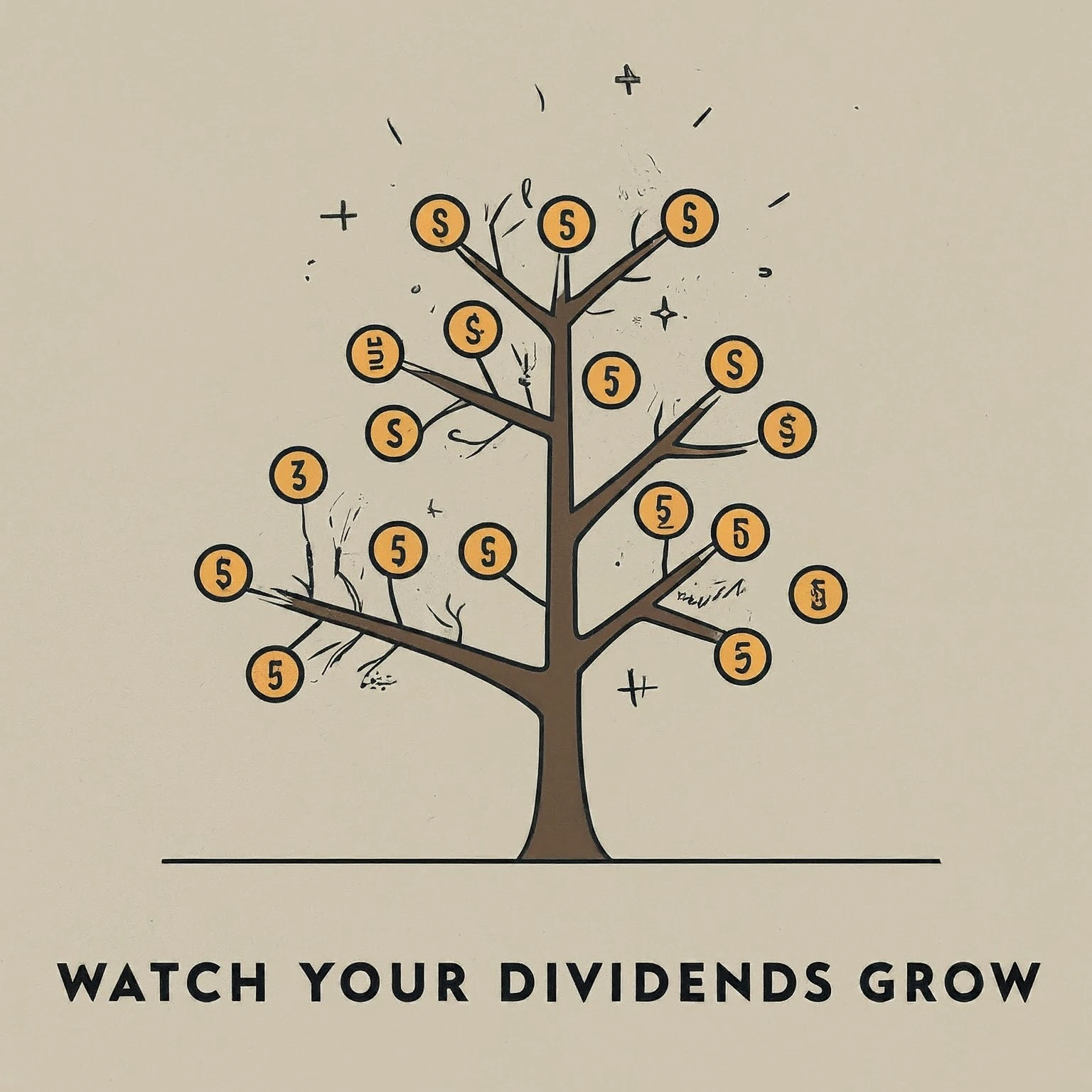
Best Sectors for Dividend Investing in 2024
Stock Market Fundamentals | over 1 year ago
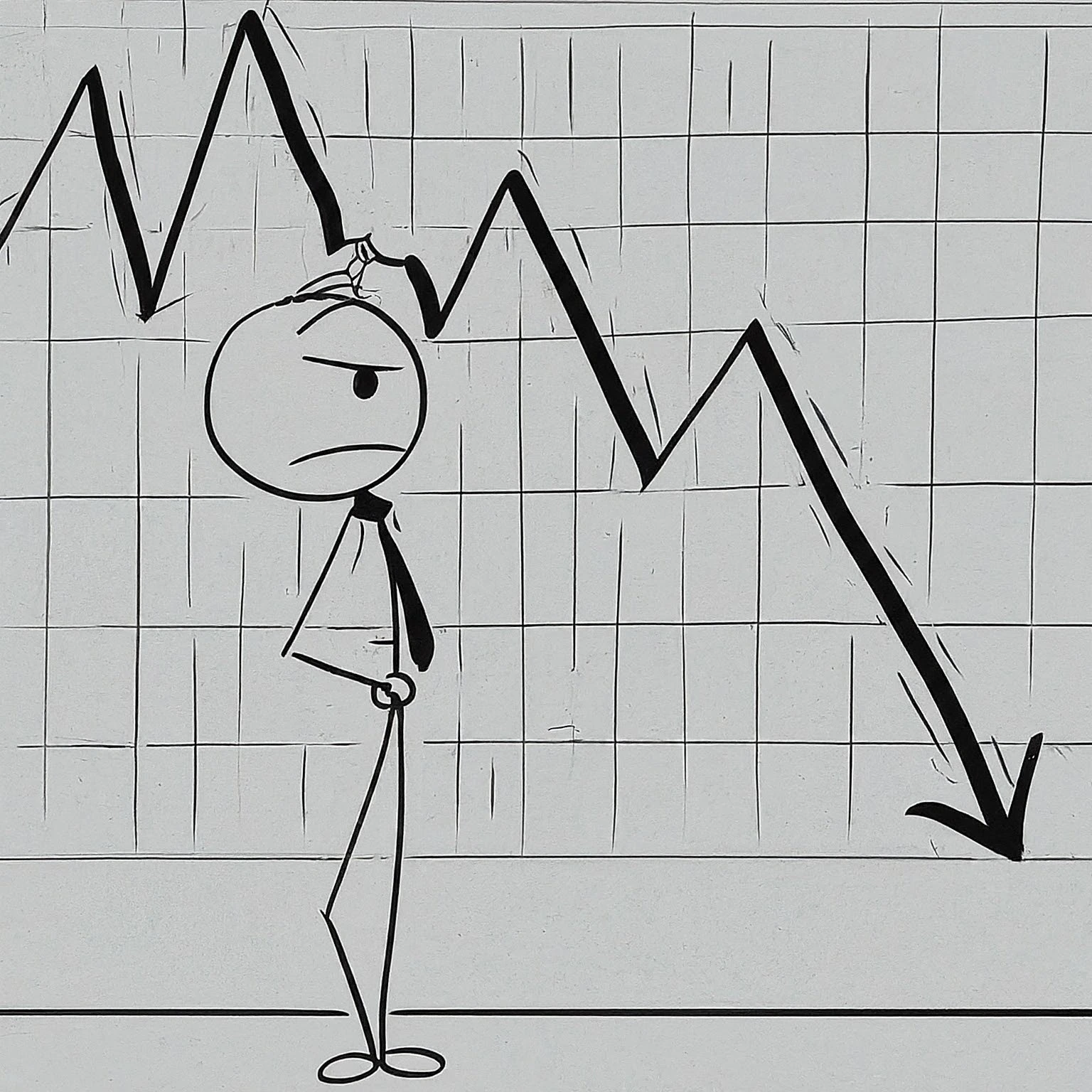
The Impact of Interest Rates on Dividend Stocks
Stock Market Fundamentals | over 1 year ago

Top 10 Dividend Stocks for Consistent Returns in 2024
Stock Market Fundamentals | over 1 year ago
Frequently Asked Questions
What is dividend investing?
Dividend investing is an investment strategy where you buy stocks or other securities that regularly pay out a portion of their earnings as dividends. The goal is to generate a steady income stream, which can be reinvested or used as regular cash flow.
Why do companies pay dividends?
Companies pay dividends to share a portion of their profits with shareholders. It’s a way to reward investors for their support and confidence in the company. Dividends can also signal a company’s financial health and stability.
What types of companies are best for dividend investing?
Investors typically look for companies with a history of stable or increasing dividend payments. These companies are often financially strong, with consistent earnings and cash flow. Common sectors include utilities, consumer goods, and healthcare.
How are dividend payments made?
Dividends are usually paid out quarterly, but some companies may pay them monthly or annually. The payment is made per share, meaning the more shares you own, the higher your dividend payment.
What is dividend yield, and why is it important?
Dividend yield is a financial ratio that shows the annual dividend payment as a percentage of the stock’s current price. It helps investors compare the income potential of different dividend-paying stocks. A higher yield may indicate a better income opportunity, but it’s important to assess the company’s overall financial health as well.
What is dividend reinvestment?
Dividend reinvestment is when you use the dividends received to buy more shares of the same stock. Many companies and brokers offer Dividend Reinvestment Plans (DRIPs) that automatically reinvest your dividends, helping to grow your investment over time.
What are the risks of dividend investing?
While dividend-paying stocks are often seen as safer, they are not risk-free. Risks include dividend cuts if a company’s profits decline, and potential capital losses if the stock price falls. It’s important to diversify and not rely solely on dividend income.
Can dividend investing provide both income and growth?
Yes, dividend investing can provide income through regular payments and potential capital appreciation if the stock price increases. Many investors choose dividend stocks for a balance of stability and growth potential in their portfolios.
How do taxes affect dividend income?
Dividend income is typically subject to taxes. In many countries, qualified dividends are taxed at a lower rate than ordinary income, but this can vary. It’s important to understand the tax implications based on your location and tax bracket.
What should I look for when selecting dividend stocks?
When selecting dividend stocks, consider the company’s dividend yield, payout ratio (the percentage of earnings paid as dividends), dividend history, and overall financial health. Companies with a lower payout ratio often have more room to increase dividends in the future.
How does dividend investing fit into a retirement strategy?
Dividend investing can be an effective strategy for retirement, providing a steady income stream to cover living expenses without needing to sell off assets. It’s particularly popular among retirees looking for passive income and portfolio stability.
Can I combine dividend investing with other strategies?
Yes, dividend investing can be combined with other strategies like growth investing or value investing. For example, you might choose high-dividend stocks for income while also investing in growth stocks for capital appreciation. This approach helps diversify your portfolio and balance risk.
Explore Dividend Investing


